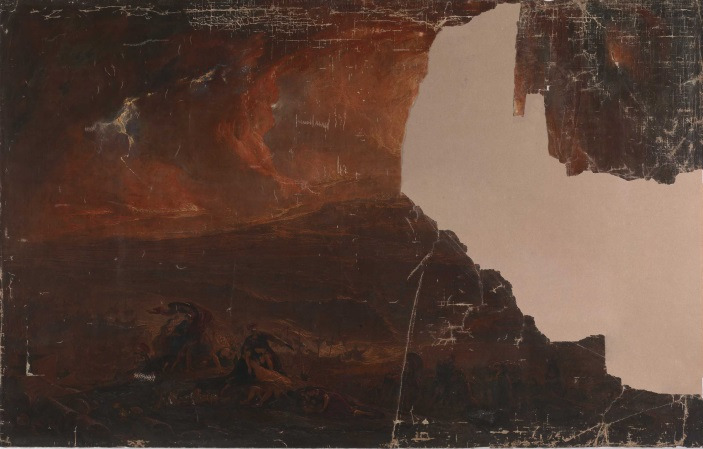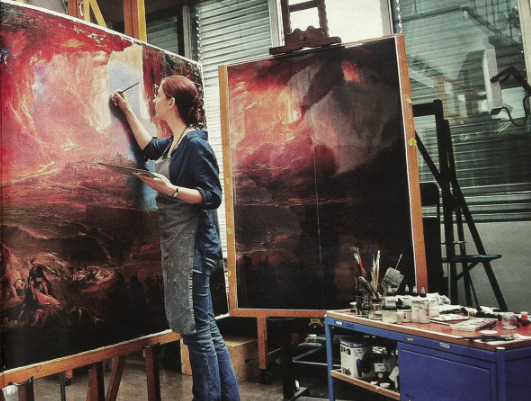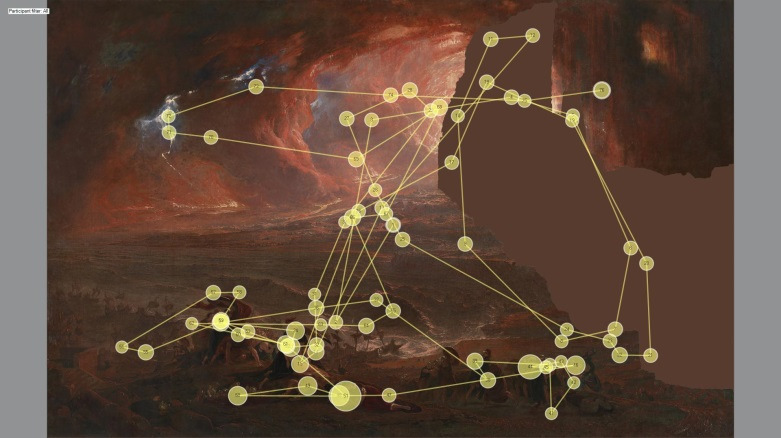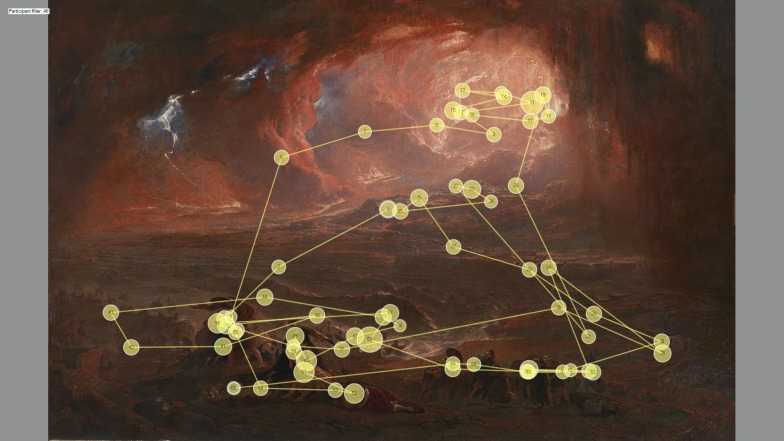A vision of destruction restored: Using eyetracking to guide the restoration of John Martin’s “The Destruction of Pompeii and Herculaneum”
Submitting Institution
Birkbeck CollegeUnit of Assessment
Psychology, Psychiatry and NeuroscienceSummary Impact Type
CulturalResearch Subject Area(s)
Medical and Health Sciences: Neurosciences
Psychology and Cognitive Sciences: Psychology
Summary of the impact
John Martin's painting `Destruction of Pompeii and Herculaneum'
was damaged and considered lost until advances in conservation made a
restoration feasible. The question remained of how to fill the lost
section without generating attentional distraction. Together with TATE
Britain, Tim J. Smith used eyetracking to identify restoration procedures
that directed gaze towards the remaining content and allowed full
comprehension of the painting's subject matter. The restored painting is
now on permanent display at TATE. This study is the first to apply
eyetracking and vision science to art conservation, and has been received
with great interest by the international conservation community.
Underpinning research
Whether we appreciate a work of art or a computer screen, we utilise the
same sensory and cognitive apparatus. Understanding how visual mechanisms
construct our experience of a painting is important for understanding how
the composition of a painting can influence our experience. Until
recently, scientific understanding of visual cognition has rarely been
applied to visual art, and artists had to intuit viewer cognition through
introspection. The work of Tim J. Smith aims to apply contemporary
theories and methodologies from visual cognition to visual art and visual
media. His research uses eye tracking to record eye movements and to
determine how they are controlled both by a visual stimulus and by viewer
cognition. Due to the limitations of the eye, we are only able to perceive
detail in an area about 2 degrees around the centre of our gaze (where 360
degrees would encircle our head). We are unaware of the incomplete nature
of our visual experience, as eye movements quickly bring any relevant
object into this central region.
By recording eye movements and fixations, we can gain insights into what
viewers are most likely to perceive and remember of a scene. Smith's
research has shown that how long we fixate objects in a scene influences
whether we later remember them (Rayner, Smith, Malcolm, & Henderson,
2009), and that fixation durations are determined by the currently fixated
object and our previous fixations (Smith & Henderson, 2011). Smith has
shown that image features such as colour, luminance, clutter and motion
influence where we look (Henderson, Chanceaux, & Smith, 2009; Smith
& Mital, in press). Manipulation of these features can be used by
painters and film directors to guide attention (Smith, 2013). By using
computer vision techniques to identify salient features of an image that
might capture attention and computational modelling of attention and eye
movements (Nuthmann, Smith, Engbert, & Henderson, 2010), Smith's
research has provided detailed insight into the relationship between an
image and how it is cognitively processed by a viewer. Particularly
relevant for the work with TATE Britain is the fact that contours and
edges involuntarily attract eye movements, while regions with low spatial
frequency (i.e., uniform or blurred areas) tend to be avoided during
visual exploration.
The restoration of the John Martin painting (section 4) presented a novel
challenge for Smith. The loss of a large part of the painting's canvas
raised the question how to fill the lost section in a way that would not
distract from the existing content. The traditional approach initially
favoured by the TATE conservation team was to fill the loss with a neutral
colour, as proposed by Cesare Brandi ("Theory of Restoration", 1963) on
the basis of gestalt principles. Smith's research into how visual features
influence eye movements and attention suggested that such a neutral infill
would be detrimental and distract from the main content. His work with
TATE Britain employed a combination of eye tracking, computational
analysis of image features and gaze to determine the optimal method of
restoring Martin's painting.
References to the research
Smith, T. J. (2013) Watching you watch movies: Using eye tracking to
inform cognitive film theory. In A. P. Shimamura (Ed.), Psychocinematics:
Exploring Cognition at the Movies. New York: Oxford University
Press.
Smith, T. J., & Henderson, J. M. (2011) Looking back at Waldo:
oculomotor inhibition of return foes not prevent return fixations. Journal
of Vision, 11(1): 3, 1-11.
Nuthmann, A., Smith, T.J., Engbert, R., & Henderson, J.M. (2010).
CRISP: A computational model of fixation durations in scene viewing. Psychological
Review, 117, 382-405.
Henderson, J.M., Chanceaux, M., & Smith, T.J. (2009) The Influence of
clutter on real-world scene search: Evidence from search efficiency and
eye movements. Journal of Vision, 9(1):32, 1-8.
Rayner, K., Smith, T.J., Malcolm, G.L., & Henderson, J.M. (2009). Eye
movements and visual encoding during scene perception. Psychological
Science, 20, 6-10
Smith, T. J., & Mital, P. K. (2013). Attentional synchrony and the
influence of viewing task on gaze behaviour in static and dynamic scenes.
Journal of Vision, 13(8):16, 1-24.
Details of the impact
John Martin was a British artist whose epic painting, Destruction of
Pompeii and Herculaneum (1821) was a central work of his apocalyptic
sublime style, which has influenced popular representations of
catastrophes such as Lord Of The Rings and Hollywood disaster movies.
Ironically, the painting suffered its own catastrophe when it was
extensively damaged following the 1928 Thames flood, including the loss of
approximately one-fifth of the canvas (Figure 1, left).

 Figure 1: Left = John Martin's The Destruction of Pompeii
and Herculaneum before treatment. Right = Tate conservator
hand-restoring the painting based on the life-sized digital composite
(displayed to the right). Photograph courtesy of Sunday Times (published
Sunday 4th September, 2011).
Figure 1: Left = John Martin's The Destruction of Pompeii
and Herculaneum before treatment. Right = Tate conservator
hand-restoring the painting based on the life-sized digital composite
(displayed to the right). Photograph courtesy of Sunday Times (published
Sunday 4th September, 2011).
The painting was considered lost until advances in conservation
techniques made a restoration feasible. However, the question of how to
fill the lost section without distracting from the remaining portion
remained. To answer this question, Dr. Smith was consulted. He worked with
the conservation department of TATE from October 2010 to September 2011.
Together with the lead conservator, Smith created a digital reconstruction
of the complete canvas by integrating a digitized version of a smaller
intact copy by the artist. Digital manipulation of the reconstructed
version created a "best guess" of what the full original might have looked
like. The lost section was digitally altered to create several alternative
infill options, including a neutral colour infill (Figure 2, left), a
lower-contrast version, and an "abstracted" version with less edge
information. Computational saliency analysis by Smith predicted that
viewer attention would be undesirably attracted to the edge of the loss in
all versions, except for the full restoration and the "abstracted"
version. To validate these predictions, each version was presented to
twenty viewers. Eye movements were recorded using a Tobii TX300 head-free
eyetracker to approximate the conditions under which the painting would be
viewed in a gallery. Eyetracking illuminates which parts of the painting
attract attention (dots in Figure 2 indicate where the eyes stopped during
fixations), and how attention is shifted (Figure 2, lines). Analysis of
eye movements for the full digital restoration (Figure 2, right) revealed
that viewers spent most time fixating the mouth of the volcano and the
characters in the foreground. With the neutral colour infill (Figure 2,
left), the edges of the loss distracted from the original content, and
viewers failed to comprehend the subject matter of the painting when
quizzed afterwards. Prior to this eytracking evidence, TATE conservators
were considering the traditional technique of using a neutral infill to
replace the loss. Demonstrating the destructive impact this would have on
attention and comprehension led them to take the bolder step of a full
restoration with abstracted features in the restored section, to bias
attention towards the original content (Figure 1, right).

 Figure 2: Gaze scanpaths for one participant viewing the Neutral
Infill restoration (left) and full restoration (right) of the painting.
Dots represent fixations; lines represent saccades.
Figure 2: Gaze scanpaths for one participant viewing the Neutral
Infill restoration (left) and full restoration (right) of the painting.
Dots represent fixations; lines represent saccades.
The restored painting went on display at TATE Britain as part of a John
Martin retrospective in September 2011. Critics of the painting
restoration plans were universally appreciative of the finished product: "Should
the canvas be made good and the missing portion left bare? ...Or should
a full restoration be attempted, with the missing portions repainted,
exactly as they were...? Happily, the Tate chose the latter."
(Waldemar Januszcak, Sunday Times, 2011). This view is mirrored by the
curator of the exhibition "The whole process behind making this
[restoration] decision was ... exemplary of how technical research,
experiment and curatorial and conservation can productively be brought
together.....A painting which has been in storage and neglected for over
80 years can be brought back to public view, and then not as a
`artefact' or technical curiosity, but as a powerful work of art.".
The painting has now been re-entered into the TATE catalogue and again
serves to illustrate John Martin's role in British art history. The
experimental and computational techniques used in this project have been
positively received by the painting conservation community at an
international conference (Maisey et al., 2011). This novel approach to
restoration has obvious potential for future application in a domain where
decisions are usually based on intuition rather than empirical fact.
According to TATE's lead curator "What would have been a curatorial
hunch was bolstered in very important ways by [the] empirical evidence."
For the lead conservator of the painting, the project with Smith "has
changed the way I work on a day to day basis" (sources 2 and 3 below).
Sources to corroborate the impact
(Full URLs and additional tinyurl links have been provided for all
weblinks. Copies of all source materials are available upon request if
external weblinks are no longer operational.)
- Maisey, S., Smithen, P., Vilaro-Soler, A., & Smith, T. J. (2011)
Recovering from destruction: the conservation, reintegration and
perceptual analysis of a flood-damaged painting by John Martin. International
Council of Museums: Committee for Conservation. Published Proceedings.
Lisbon, Portugal, September 19-23, 2011. PDF version of this article:http://www.bbk.ac.uk/psychology/our-staff/academic/tim-smith/documents/1320_459_MAISEY_paper_EN1.pdf/view
http://tinyurl.com/prba49e
- Lead conservator on Martin painting whilst at TATE Britain. Contact
details are provided separately. A copy of a letter from the conservator
describing the restoration project and the importance of using eye
tracking measures is available upon request.
- Lead Curator pre-1800 British Art, Tate. Curator on John Martin,
Apocalypse exhibition September 2011 - January 2012. Contact details are
provided separately. A copy of a letter from the lead curator describing
the restoration project and Smith's central role in this project is
available upon request.
- Guardian Online, article on restoration. Monday 19th
September, 2011
http://www.guardian.co.uk/artanddesign/2011/sep/19/john-martin-pompeii-painting-restored
http://tinyurl.com/5wkdjyy
- Guardian Online, Science Blog. Article by Dr Tim J. Smith on
experiment and painting restoration. Monday 3rd October,
2011.
http://www.guardian.co.uk/science/blog/2011/oct/03/vision-science-john-martin-destruction
http://tinyurl.com/owuqhu5
- BBC Breakfast, BBC1. Report on Smith's experiment at TATE and painting
restoration. Broadcast 25th October, 2011.
- Channel 4 News, Channel 4. Report on Smith's experiment at TATE/
Broadcast 19th September, 2011.
- Sunday Times, Culture magazine. Sunday 4th September, 2011.
http://www.thesundaytimes.co.uk/sto/Magazine/Features/article762110.ece
http://tinyurl.com/ou5o6ay